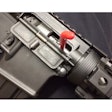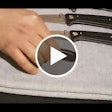Do you know how fast you can shoot and still be accurate?
I decided to determine my "accurate rate of fast or rapid fire" after two of my closest shooting buddies, including one who trains military special operations personnel, noticed that whenever I field-tested Glock pistols, 1911s or Smith & Wesson K- and L-frame revolvers, I tended to shoot much tighter groups than when I shot some of my favorite DA/SA pistols.
Before I go any further, let me say for the record that this discussion has nothing to do with your ability to qualify with a perfect score with a particular firearm. I mention this because I don't want to give you the wrong impression and make it sound as if my DA/SA or DAK (Double Action Kellerman) SIG pistols are not accurate firearms.
To prove this point, allow me to mention that I recently qualified on a 50-round law enforcement certified course of fire and achieved a 250 out of 250 point score with my DA/SA SIG P220 compact .45, a 250 out of 250 with a DA/SA SIG P239 9mm and a 245 out of 250 with my DA/SA SIG P229 in .40 S&W. Clearly, these numbers prove I'm a very good shot with various DA/SA SIG pistols.
When you qualify with firearms on any law enforcement course of fire, you can easily achieve a perfect score or a close-to-perfect score without delivering one large 50-round cluster or super tight group of bullets fired in the direct center of the chest area of the target.
The average law enforcement officer isn't tested or required to determine their ability to deliver precision shot placement, especially when you consider that the scoring area of a TQ19 Police Firearms Qualification target has an official scoring area that is roughly 11 inches wide by 16 inches high not counting the head.
The reason it's important to know your accurate rate of rapid or fast fire is because there may come a time when it may be necessary to deliver precise shot placement to safely end a hostage situation or to engage multiple violators in a Close Quarter Battle situation. Remember, it's to your advantage to stop all threats from continuing to be a threat with the least number of bullets fired when it is possible to do so because you're accountable for every round fired in any authorized use of deadly force.
It is also important to be skilled enough to use the least number of bullets possible to end any authorized use of deadly force situation to prevent the need for a combat reload in the presence of one or more adversaries. No matter how fast you can reload your firearm under stress, you risk exposure to attack and being overpowered, if you're alone and don't have suitable cover to hide behind when you execute a combat reload.
This is one reason it pays to carry a backup gun. Likewise, if your adversary is behind good cover, or is wearing body armor, you may have to "place your shots" in certain parts of your opponent's body, which is more likely to happen if you're a more proficient shooter.
After a great deal of experimentation, I have found that certain handguns with certain trigger systems tend to be easier to shoot with more precision than other makes and models. In my case, I can shoot faster and still deliver excellent connect-the-dots shot placement, when I shoot certain Glocks, certain SIGs, any well-made all-steel 1911 in 9mm or .45 ACP and various Smith & Wesson K- and L-frame revolvers such as my six-shot stainless steel .38 Special/.357 Magnum Model 686 with a four-inch barrel.
If you wish to train to improve your accurate rate of rapid or fast fire, you can practice different types of shooting drills that will enable you to hone your accuracy and rate of fire or speed with a patrol rifle and a handgun. You can begin by shooting slowly and working your way up to a faster pace, as long as you continue to deliver accurate shot placement. Or you can begin by shooting as quickly as you can pull the trigger, then back off until you find the right tempo that allows you to be a precision shooter. [PAGEBREAK]
To ensure you train properly, monitor your progress by inspecting your target after each drill and mark the hits and misses with a colored felt-tip pen. When you see one or more shots located outside of the scoring area that represents one or more misses, back off a bit and try the same drill again with a fully loaded firearm. This time, adjust your rate of fire by slowing down enough to find that perfect combination of speed and accuracy.
It also helps, if you periodically put up a fresh target. Be patient and take your time progressing from one drill to another. Repeat each drill at least two or three times in each range session, but don't over tax yourself because as frustrating as this training can be, it will become more enjoyable once you see some level of improvement with your accuracy and your rate of fire.
The next drill is to take on two man-sized qualification targets. Always remember to engage each target representing a serious threat with one round, as soon as possible, before you deliver whatever number of additional follow-up shots are required to stop other threats. Remember, when facing multiple adversaries you should always engage the most serious threat first, before engaging other threats.
Depending on the situation, it may also make sense to quickly fire one round into each threat before you sweep back and forth and continue delivering well placed follow-up shots into each adversary. Clearly, this can be an even greater challenge, if you're engaging one or more violent adversaries, while working alone in a more remote area where your closest backup may take 30 minutes to reach your location running Code 3.
Please understand that I'm not advocating that you spray and pray for a hit. What I am advocating is that LEOs go beyond just trying to qualify with a passing score. It's also important to maintain a pace that you're comfortable with because a good hit is always better than a quickly delivered miss.
I truly believe that if you increase your training tempo and use the firearms that work best in your hands, you'll increase your confidence and gunfighting skill. Remember, the point of this training exercise is to improve your capabilities. When you think you're at the top of your game, train some more.
Three Drills to Improve Speed and Accuracy
One shooting drill that will help improve your speed and accuracy is to draw and fire one round as fast as possible as soon as you're on target then return to the ready pistol position and repeat this process until your pistol is empty.
Another shooting drill is to fire a double tap (two back-to-back shots), then holster your handgun or return to the ready pistol position where you can continue this drill until your firearm is empty. After executing a combat reload, you can continue both drills while you increase or decreases your speed or rate of fire until you can keep all rounds fired in the scoring area of the target.
As you progress, you can eventually work your way up to firing strings of five rounds at a time. Another drill that's critical to perform is to empty your firearm into a man-sized target at different CQB distances as fast and as accurately as possible then execute a combat reload so you can "precisely" and "quickly" deliver another string of bullets at the same target.
Visualize Your Pace of Fire
Should you be caught out in the open when you need to execute a combat reload you should blade your body from the threat or threats and get as small as possible.
I also recommend that you visualize the pace in which you wish to fire by repeating the level of speed you wish to fire your rifle or pistol by thinking to yourself that when you open fire the rapport of your firearm should sound like BAM!, BAM!, BAM! BAM! BAM! or BAM! BAM! … BAM! BAM! … BAM BAM.
Taking a split second to visualize what you need to do can help you execute your actions with more conviction, when it comes time to pull the trigger.




















